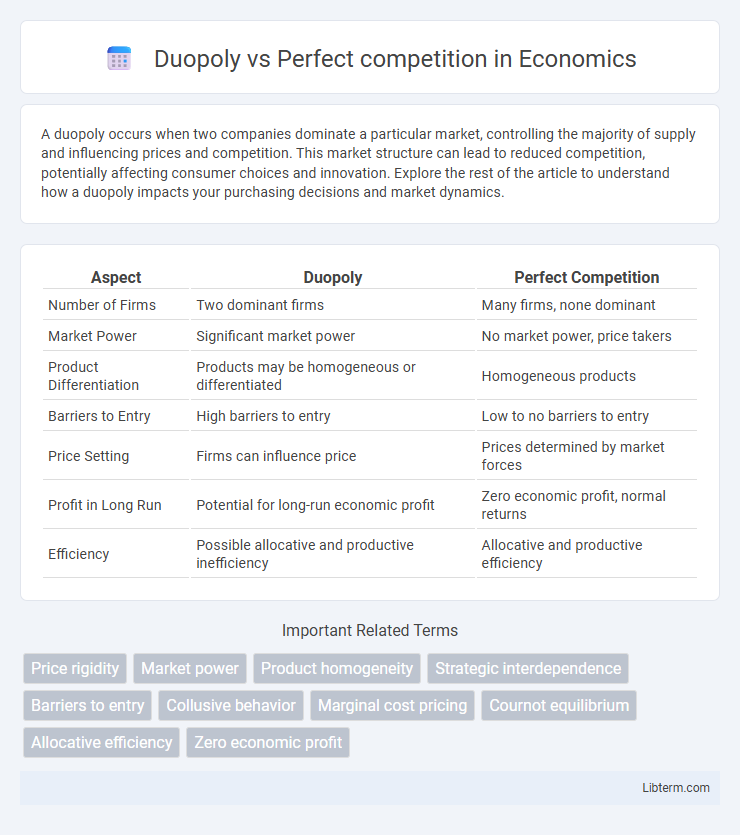A duopoly occurs when two companies dominate a particular market, controlling the majority of supply and influencing prices and competition. This market structure can lead to reduced competition, potentially affecting consumer choices and innovation. Explore the rest of the article to understand how a duopoly impacts your purchasing decisions and market dynamics.
Table of Comparison
| Aspect | Duopoly | Perfect Competition |
|---|---|---|
| Number of Firms | Two dominant firms | Many firms, none dominant |
| Market Power | Significant market power | No market power, price takers |
| Product Differentiation | Products may be homogeneous or differentiated | Homogeneous products |
| Barriers to Entry | High barriers to entry | Low to no barriers to entry |
| Price Setting | Firms can influence price | Prices determined by market forces |
| Profit in Long Run | Potential for long-run economic profit | Zero economic profit, normal returns |
| Efficiency | Possible allocative and productive inefficiency | Allocative and productive efficiency |
Introduction to Duopoly and Perfect Competition
Duopoly is a market structure characterized by two dominant firms that control the majority of market share, influencing prices and output decisions strategically. Perfect competition features numerous small firms selling identical products, with no single firm able to influence market price, leading to efficient resource allocation. The contrast highlights strategic interdependence in duopoly versus price-taking behavior in perfect competition.
Key Characteristics of Duopoly
Duopoly is a market structure dominated by two firms, each holding significant market power and influencing prices and output decisions. Unlike perfect competition, where numerous small firms compete with no single entity controlling the market, duopolies feature interdependent decision-making and strategic behavior such as price setting, collusion, or non-price competition. Key characteristics include high barriers to entry, product differentiation or homogeneity, and the potential for oligopolistic outcomes like price rigidity and market sharing.
Main Features of Perfect Competition
Perfect competition is characterized by numerous small firms producing homogeneous products, ensuring no single seller can influence market prices. The market features perfect information and free entry and exit, leading to allocative and productive efficiency. Firms are price takers, with equilibrium established where marginal cost equals marginal revenue, maximizing consumer and producer surplus.
Market Structure Comparison
Duopoly market structure is characterized by two dominant firms controlling the majority of market share, leading to interdependent pricing and strategic decision-making, while perfect competition features numerous small firms with no single entity influencing market prices. In a duopoly, barriers to entry are typically high, allowing limited competition and potential for collusion, whereas perfect competition has no barriers, promoting free entry and exit of firms. Price setting in duopoly often results in price rigidity or price wars, contrasted with perfect competition's equilibrium price determined by supply and demand forces.
Price Determination Mechanisms
In a duopoly, price determination is heavily influenced by the strategic interactions between the two dominant firms, often resulting in price rigidity or price wars depending on their competitive behavior and market power. In contrast, perfect competition features a large number of small firms where price is determined by the intersection of overall market supply and demand, leading to prices that reflect marginal cost. This fundamental difference means duopolies have greater control over price-setting, while perfect competition drives prices toward equilibrium with no firm pricing above marginal cost.
Barriers to Entry and Exit
Duopoly markets have high barriers to entry and exit due to significant capital requirements and strategic deterrence by existing firms, limiting new competitors and reducing market fluidity. In perfect competition, barriers to entry and exit are negligible, enabling numerous firms to freely enter or exit the market based on profit opportunities. The ease of market participation in perfect competition fosters efficient resource allocation and intense price competition.
Impact on Consumer Welfare
Duopoly markets often result in higher prices and reduced output compared to perfect competition, leading to diminished consumer welfare due to limited choices and potential collusion between firms. Perfect competition fosters maximum consumer welfare by ensuring prices equal marginal costs and promoting allocative efficiency, thus maximizing consumer surplus. The contrast highlights how market structures influence price setting, product variety, and overall consumer benefits.
Efficiency and Resource Allocation
Duopoly markets often experience inefficiencies due to strategic behavior between the two dominant firms, leading to higher prices and reduced output compared to perfect competition, where numerous firms drive prices to marginal cost. Perfect competition achieves allocative efficiency by ensuring resources are distributed to produce goods where consumer marginal benefit equals marginal cost. In contrast, duopolies may allocate resources suboptimally, resulting in deadweight loss and less consumer surplus.
Real-World Examples of Duopoly and Perfect Competition
Duopoly markets are exemplified by the Boeing-Airbus rivalry in the commercial aircraft industry, where two dominant firms control most of the market share, leading to strategic pricing and innovation competition. In contrast, perfect competition is observed in agricultural markets like wheat or corn, where numerous small farmers sell nearly identical products with no single producer influencing market prices. These real-world examples highlight how duopolies concentrate market power among few players, whereas perfect competition features many sellers and buyers ensuring price equilibrium.
Conclusion: Duopoly vs Perfect Competition
Duopoly markets feature limited competition with two dominant firms controlling prices and output, often leading to strategic behavior and less consumer welfare compared to perfect competition. Perfect competition maximizes efficiency, with numerous firms producing homogeneous products and prices determined solely by supply and demand. The contrasting market structures highlight the trade-offs between market power concentration in duopolies and the idealized efficiency of perfect competition.
Duopoly Infographic

 libterm.com
libterm.com